ARCM Facilitates Update of Radio Control System for Army’s UH-60M
Dec 15, 2023 —
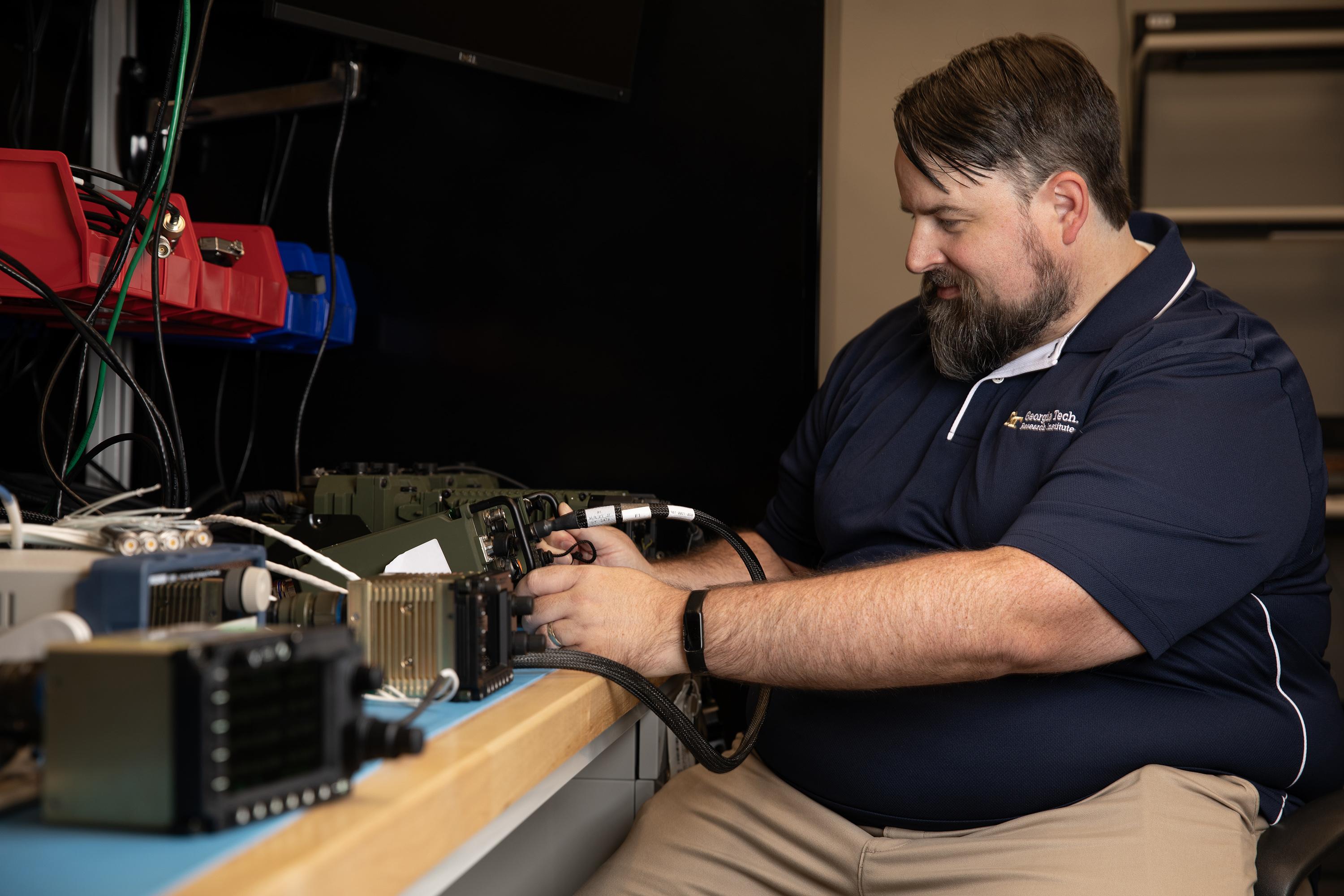
GTRI Senior Research Engineer Scott Tompkins is shown reconfiguring an Air Ground Networking Radio (AGNR) for testing at a lab bench. (Credit: Sean McNeil)
Using a model-based systems engineering (MBSE) approach, researchers from the Georgia Tech Research Institute (GTRI) are developing the software necessary to integrate new control, radio, and cryptographic capabilities into UH-60M Black Hawk helicopters, which are mainstays of the U.S. Army’s helicopter fleet.
The Aviation Radio Control Manager (ARCM) software will enable the sustainment of enduring fleet aircraft by employing a Modular Open Systems Approach (MOSA) to replace obsolete, out-of-production radio equipment and set the stage for future communications suite enhancements. The reusable and adaptable ARCM software is projected to be employed on additional Army aircraft in the future, providing benefits of software reuse, potentially leveraged for future efforts.
Now in its third round of software development, ARCM is due to be flight-tested next summer and installed on the first group of UH-60M aircraft in 2025. The project, supported by the U.S. Army’s PEO Aviation in Huntsville, Alabama, will comply with the service’s Future Airborne Capability Environment (FACE™) Technical Standard, Edition 3.1.
Model-based approaches are being used across the Department of Defense (DoD) to accelerate the development of new platforms and updates to existing ones. Beyond reducing costs and getting new capabilities to warfighters more quickly, the process can streamline procurement by clearly spelling out system specifications and key interfaces.
“Model-based approaches have been a very central part of how we’ve approached ARCM, and the return on investment for ARCM generally and for the MBSEs specifically, is based largely on a business case in which you spend a little more to get the models in place and design the system to interface with multiple components,” said Scott Tompkins, a GTRI senior research engineer who leads the project. “Investments in MBSE can provide huge savings when you reuse the work for other systems and shorten the cycle times to bring new capabilities to aircraft platforms.”
In this first application, the ARCM software will facilitate three major improvements for the UH-60M: (1) replacement of the control head unit (CHU) that aircrews use to operate radio equipment, (2) replacement of an obsolete tactical communications radio, and (3) upgrade of cryptographic systems used for secure communications. The replacement radio hardware, which is being built by multiple vendors, interfaces with the aircraft’s unmodified flight management system (FMS) via the ARCM.
“The aircraft needed a new radio, but the Army doesn’t necessarily desire to change the approved and fielded Black Hawk FMS Operational Flight Program (OFP) to integrate that radio,” Tompkins said. “In this project, we are translating the radio’s interface, so they don’t have to change the main aircraft software. This will address three issues at once through software.”
Two different radios with comparable functionality will be available as options for replacing the existing ARC-201D unit. The ARCM software will make the difference between those two alternatives invisible to aircrews and other systems in the aircraft. The software will also allow transparent substitution of radio equipment on Black Hawks used by foreign nations, and it is designed for future support of alternate radio equipment used by National Guard Black Hawks for collaboration with civil defense and domestic first responder agencies.
“From the models, we generated the vast majority of the code used in the ARCM, and that code meets the FACE Edition 3.1 standard for MOSA software,” Tompkins said. “We have also deployed a development, security, and operations (DevSecOps) pipeline to support our software repository and perform automated testing of the products as part of best practices in software development and acquisition. We are also doing full end-to-end information assurance accreditation.”
Though only the UH-60M work has been performed so far, the work done on ARCM could also be used with CH-47F Chinook and AH-64 Apache helicopters, as well as the Gray Eagle uncrewed aircraft system (UAS). The Army’s Future Vertical Lift (FVL) platforms could also take advantage of the modeling done for ARCM.
“The FACE model provides the ability to unambiguously communicate about interfaces,” Tompkins said. “We have all the contextual meaning for the data so that when we hand this over, there’s no question about what the data is and how to interpret the messages. We have captured all of that in the model.”
Beyond ensuring compatibility with existing Black Hawk systems, GTRI is also making sure the replacement interface – graphics and buttons that control the radio equipment – makes sense to the aircrews that will use it. “We recently completed another round of crew station working group meetings where we had pilots review our graphical user interface (GUI) and the functionality,” said Tompkins. “It was very encouraging, and we continue to get positive user feedback.”
GTRI is scheduled to deliver its full technical data package (TDP) to the Army in January 2024. The ARCM program will submit the software and its associated development artifacts to the Army for an airworthiness qualification to a DO-178C Design Assurance Level ‘C’ level of rigor in Q3 of fiscal year 2024. It will then be reviewed for a first test flight in early summer of that year. Once flight testing is over, ARCM and the new hardware can begin rolling out to Army units in 2025.
GTRI expects to be part of the test flights and then move on to support the development of additional capabilities, including new waveforms being developed by the radio vendors. Discussions are also underway regarding potential applications to other Army rotorcraft.
“Our goal is to have an ARCM release annually that brings new capabilities,” Tompkins said. “With software-defined radios, the vendors are constantly innovating and improving waveforms. We want to get those enhancements out to aircrews as soon as possible.”
The ARCM program has involved multiple labs within GTRI, as well as Tucson Embedded Systems, which is a FACE Verification Authority.
“We have put together a great multidisciplinary team of modelers, software developers, information assurance experts, human factors specialists, and human systems engineers,” Tompkins said. “It’s been a spectacular project – working with a wonderful team – and I’m really excited to see the first test flight.”
DISCLAIMER: This article contains views and opinions that are not official U.S. Army positions.
Writer: John Toon (john.toon@gtri.gatech.edu)
GTRI Communications
Georgia Tech Research Institute
Atlanta, Georgia
The Georgia Tech Research Institute (GTRI) is the nonprofit, applied research division of the Georgia Institute of Technology (Georgia Tech). Founded in 1934 as the Engineering Experiment Station, GTRI has grown to more than 2,900 employees, supporting eight laboratories in over 20 locations around the country and performing more than $940 million of problem-solving research annually for government and industry. GTRI's renowned researchers combine science, engineering, economics, policy, and technical expertise to solve complex problems for the U.S. federal government, state, and industry.
AGNR control head unit (CHU) showing the pilot vehicle interface (PVI) for the GTRI-developed Aviation Radio Control (ARCM) software. (Credit: Sean McNeil)
(Interim) Director of Communications
Michelle Gowdy
Michelle.Gowdy@gtri.gatech.edu
404-407-8060
GTRI, Children’s Healthcare of Atlanta and Emory Use Wearable Sensors to Address Healthcare Worker Burnout
Dec 15, 2023 —
The team leading this project includes, from left to right: GTRI Senior Research Scientist Khatereh Hadi, Children's pediatric cardiologist Dr. Michael Fundora, GTRI Senior Research Engineer Paula Gomez, GTRI Senior Research Scientist Matthew Swarts, and Children's Director of Nursing & Allied Health Research and Evidence Based Practice Christina Calamaro, who is also an associate professor at Emory’s Nell Hodgson Woodruff School of Nursing (Photo Credit: Sean McNeil, GTRI).
Healthcare worker burnout, a topic that received significant attention during COVID-19, continues to pose risks for the nation’s health and economic wellbeing.
In 2022, nearly half of healthcare workers reported feeling burned out, up from 32% in 2018, and the number of healthcare workers who intended to look for a new job increased by 33% over that same time period, according to a recent report from the Centers for Disease Control and Prevention (CDC). Annual burnout-related turnover costs are estimated to be $9 billion for nurses and $2.6 billion to $6.3 billion for physicians, per the U.S. Surgeon General.
To address this challenge, the Georgia Tech Research Institute (GTRI), Children’s Healthcare of Atlanta and Emory University’s Nell Hodgson Woodruff School of Nursing have conducted a study using wearable sensors to better understand how the interplay of workload, stress, and sleep contribute to an elevated risk of burnout among healthcare workers and how to mitigate those risks going forward.
The group recently measured real-time movement patterns of physicians and nurses in the cardiac intensive care unit (CICU) at Children’s and collected data on their stress levels, work and sleep cycles, healthcare delivery and perceived workloads. The goal of the study is to develop a methodology that can be used by other healthcare systems across the state to minimize turnover costs by better predicting and addressing factors that trigger burnout.
“Our ultimate goal with this project is to be able to offer our methodology framework to other healthcare systems throughout Georgia so that they can identify and address the specific challenges they are facing on a more granular level,” said Khatereh Hadi, a senior research scientist at GTRI who is leading this project.
To measure stress, workload and sleep among the study participants, the team used actigraphy sensors developed by Empatica, a spin-off of Massachusetts Institute of Technology (MIT) that designs and develops artificial intelligence (AI) systems to monitor human health through wearable sensors.
“These sensors are among the few on the market that let you directly download the data you collect,” explained GTR Senior Research Scientist Matthew Swarts who led the sensor development aspects of this project.
The participants also wore tags that were connected to ultra-wideband (UWB) sensor systems installed in the ceiling of the CICU to track their movements throughout their shifts.
“Because UWB takes up more radio frequency space, it avoids interference issues that affect other technologies such as Wi-Fi and Bluetooth. This allowed us to have more penetration and better accuracy,” Swarts said.
The study collected data on 40 total participants, who were evaluated over a four-week time period. The team also used the NASA Task Load Index (NASA-TLX), a widely used assessment tool that rates perceived workload, to gather data on the participants’ workload perceptions.
Paula Gomez, a GTRI senior research engineer who led the development of the project’s research methodology, said it was rewarding bringing the theoretical aspects of this project into practical application.
“Since GTRI is the applied research arm of Georgia Tech, it is really important for us to have access to a real-world environment to test and validate the theoretical research,” Gomez said.
GTRI conducted this study with Dr. Michael Fundora, a pediatric cardiologist at Children’s who specializes in congenital heart disease and clinical research, and Christina Calamaro, the Director of Nursing & Allied Health Research and Evidence Based Practice at Children’s and an associate professor at Emory’s Nell Hodgson Woodruff School of Nursing.
Fundora and Calamaro noted that current data collection methods that examine healthcare worker burnout are done retroactively and may miss certain nuances that are crucial for developing a comprehensive understanding of the issue.
“A lot of the literature that's been done in this area looks at big data sets that, for the most part, aren’t in real time” said Calamaro. “This is one study that’s able to quantify what are the factors that may impact care at the current time and can set the stage, with the use of technology, for giving us a better measurement of what issues nurses and physicians are facing, versus going back and doing a secondary analysis of big data.”
While burnout is commonly perceived as just affecting those experiencing it, if left unchecked, it could also lead to diminished patient care and higher mortality rates, said Fundora.
“People talk about burnout in the sense that it's about the individual, and that's certainly important,” Fundora said. “But we conducted this study to understand how burnout also affects our patients because that's the only way I believe that we're going to get to the root of the problem.”
Now that the data has been the collected, it will be analyzed and interpreted before potential solutions are evaluated. The team agreed that the interdisciplinary nature of the study will help them generate more impactful solutions.
“As a physician, working on this study opened my eyes to everything I didn’t know about nurses – they are operating very sophisticated, complex equipment and nearly everything they do in the ICU has a life-or-death impact,” said Fundora. “The solution-oriented approach of GTRI also gave me a fresh perspective.”
Calamaro added: “I think every healthcare study should have an engineer involved in some way because they see things that we as healthcare professionals don’t. It's like, I never thought of that.”
Writer: Anna Akins
Photos: Sean McNeil
GTRI Communications
Georgia Tech Research Institute
Atlanta, Georgia
The Georgia Tech Research Institute (GTRI) is the nonprofit, applied research division of the Georgia Institute of Technology (Georgia Tech). Founded in 1934 as the Engineering Experiment Station, GTRI has grown to more than 2,900 employees, supporting eight laboratories in over 20 locations around the country and performing more than $940 million of problem-solving research annually for government and industry. GTRI's renowned researchers combine science, engineering, economics, policy, and technical expertise to solve complex problems for the U.S. federal government, state, and industry.
A close-up of the tags and sensors that were used to measure stress, workload and sleep among the study participants (Photo Credit: Sean McNeil, GTRI).
(Interim) Director of Communications
Michelle Gowdy
Michelle.Gowdy@gtri.gatech.edu
404-407-8060
Poor and Disadvantaged People Sit in the Dark Longer After a Storm Outage
Dec 14, 2023 —

Extreme weather events impact disadvantaged communities more harshly, and extended power outages can be dangerous and life-threatening.
Hurricanes and other extreme weather events often affect disadvantaged communities more severely, and extended power outages are some of the most harmful effects. Concerns over the intensification of hurricanes has led to new environmental justice policies that aim to mitigate the unequal impacts of major storms. Now, policy experts and engineers are directing their attention toward illuminating the causes.
Researchers at the Georgia Institute of Technology sought to investigate whether socioeconomically vulnerable households experienced longer power outage durations after extreme weather events. The team analyzed data from the top eight major Atlantic hurricanes between 2017 and 2020 that knocked out power for over 15 million customers in nine states across the southeastern U.S. The team found that people in lower socioeconomic tiers wait significantly longer to have power restored after a major storm — nearly three hours longer on average.
The interdisciplinary research team consists of Chuanyi Ji, an associate professor in the School of Electrical and Computer Engineering; Scott Ganz, a policy researcher at Georgetown University and a former Georgia Tech faculty member; and Chenghao Duan, a Ph.D. student in Ji’s lab.
Their research paper, titled “Socioeconomic Vulnerability and Differential Impact of Severe Weather-Induced Power Outages,” was published in the journal PNAS Nexus.
“Not only do extreme weather events impact disadvantaged communities more harshly, but power disruption can be dangerous and even life-threatening in certain contexts,” Ji said. “Those with fewer resources are limited in their ability to evacuate from severe weather situations, and for individuals with electric medical equipment, an extended power outage can be disastrous.”
Ji, who specializes in large-scale data analytics for power grid resilience, has done previous work on power restoration procedures involving infrastructure and utility services, but wanted to expand the work into the realm of communities. The team hypothesized that disadvantaged communities likely wait longer for power to be restored, but to get a realistic picture of the mechanisms at play, the team needed to analyze troves of data.
They obtained weather data for eight major hurricanes between 2017 and 2020 from the National Oceanic and Atmospheric Administration and additional flood databases. They also examined power failure data for 15 million customers for the same time period, which spanned nine states, 588 counties, and 108 utility service regions in the Southeast.
The team used spatial data analytics to model weather impact across regions. They then measured customers’ socioeconomic status by using the social vulnerability index, a tool produced by the Centers for Disease Control that considers indicators related to poverty, housing costs, education, health insurance, and other factors to determine socioeconomic status. Duan and Ji designed the models and estimates, and then analyzed the results to reveal the underlying relationship between customers' socioeconomic status and their power outage durations.
Their results show that, when comparing affluent communities and poor communities given the same kind of impact from weather events, poor communities experienced power outages that average 170 minutes longer. Specifically, they found that a one-decile drop in socioeconomic status is associated with a 6.1% longer outage duration. Their results indicate that there is a statistically significant relationship between socioeconomic vulnerability and the duration of time that elapses before power is restored.
“Our study also tries to rule out some possible explanations for why socioeconomically disadvantaged people take longer to get their power back on,” Ganz said. “For example, our study controls for population density in a county and the peak number of outages in that county, and we still observe that socioeconomically disadvantaged communities experience longer outages.”
He theorized that the “primary cause is that poorer communities are also likely to be more distant from critical infrastructure or require more significant repairs to power lines, but these are important questions for future research.”
The results can have important implications for policymakers, pointing to the necessity of reexamining post-storm recovery and resource allocation policies. Service and utility providers approach power recovery by adhering to procedures and regulations that are policy-driven. Current research shows that the standard procedures for restoring power following big storms, while procedurally fair, may contribute to unequal outcomes. A greater focus on communities could help to correct the issue.
“Power grid resilience is not just about the infrastructure and utility companies — it’s also about the people they serve,” Ji said. “Success in achieving policy goals depends on our ability to identify the features that contribute most to these unequal impacts, which can in turn help us design appropriate interventions to improve outcomes.”
Funding: The authors acknowledge financial support from the Georgia Tech Energy Innovation and Policy Center and the Strategic Energy Institute, Georgia Tech School of Electrical and Computational Engineering, Georgia Tech School of Public Policy, and Georgetown McDonough School of Business.
Citation: Scott C Ganz, Chenghao Duan, Chuanyi Ji, Socioeconomic vulnerability and differential impact of severe weather-induced power outages, PNAS Nexus, Volume 2, Issue 10, October 2023.
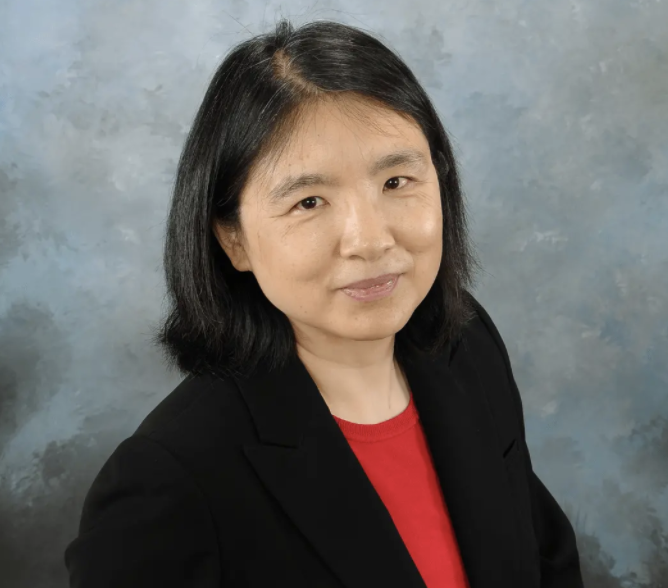
Chuanyi Ji, associate professor of Electrical and Computer Engineering at Georgia Tech
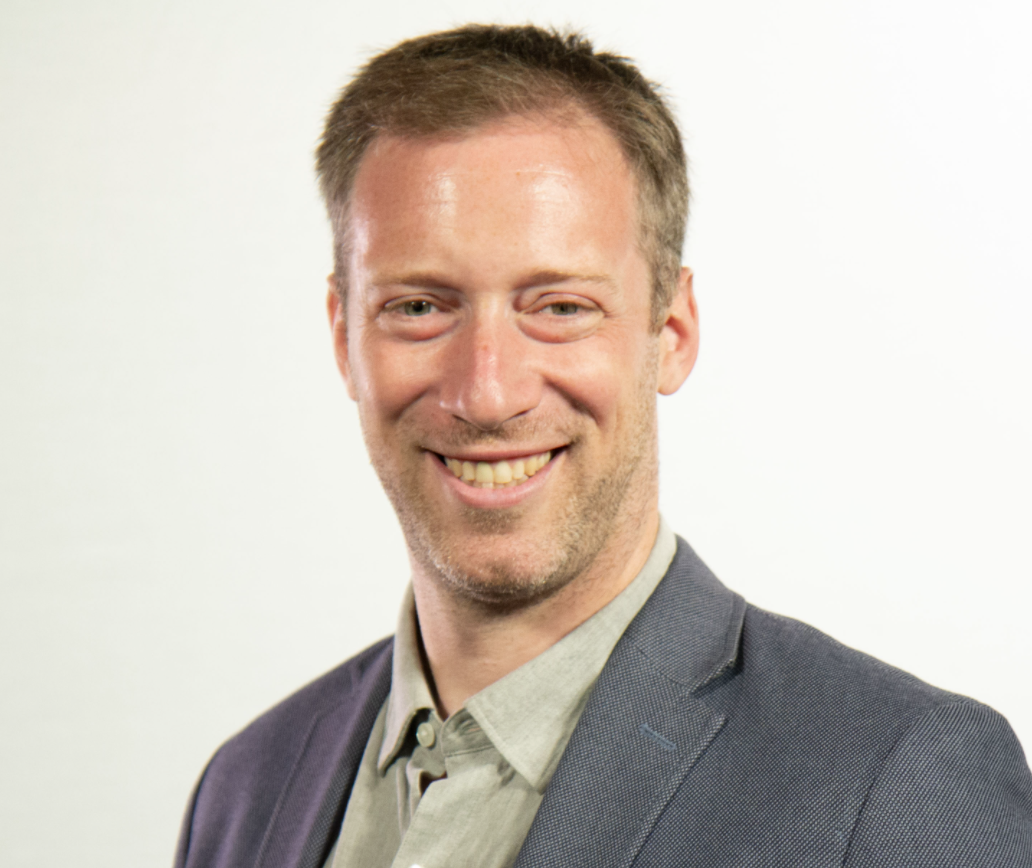
Scott Ganz, associate teaching professor at Georgetown University and research fellow at the American Enterprise Institute
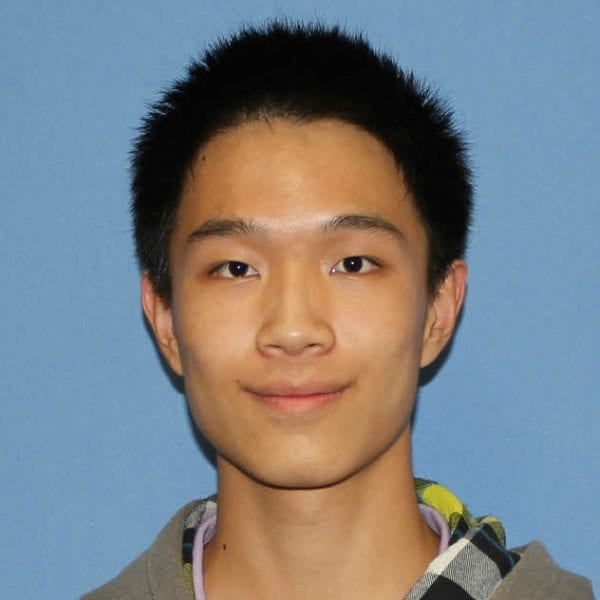
Chenghao Duan, a Ph.D. student in Ji's lab at Georgia Tech.
Catherine Barzler, Senior Research Writer/Editor
Charlotte Alexander Uses NSF Grants to Create an AI-Powered, Publicly Accessible Court Data Platform
Dec 13, 2023 —

Imagine accessing court documents and data, both civil and criminal, in the state of Georgia through a free central repository. Now imagine this access across the entire U.S. court system.
Charlotte Alexander, professor of Law and Ethics at the Georgia Tech Scheller College of Business, is working on a project that uses AI to mine the text of court records. Her work includes pulling key pieces of information out of court documents and making it freely available to attorneys, judges, prosecutors, criminal defendants, civil litigants, journalists, policymakers, researchers, and any member of the public.
Currently, court records are stored in systems that are expensive, fragmented, outdated, and hard to navigate. Alexander sees a lack of good data as a key problem impeding court reform efforts. Better data, she says, "would shed light on questions around efficiency and time of action, how long things take, and why there are delays. But it also raises big, heavy, substantive questions about bias and who wins and who loses. Does our legal system actually deliver justice, and if so, to whom?" said Alexander.
Her work, funded primarily through National Science Foundation (NSF) grants, is multi-faceted. She and a team of researchers received an initial grant from the NSF’s Convergence Accelerator Project, which was designed to fund efforts to create new sources of data and then make that data publicly available.
Working on the Federal Level
This initial work with colleagues at Georgia State University, Northwestern University, University of Richmond, and the University of Texas - Austin focused on the federal courts.
"When we started all of this on the federal level, we assembled court records from two full years of all federal cases filed, so everything filed in 2016 and 2017, we downloaded four years later. So, by 2020 and 2021, most of those cases had concluded. Now, we have this big snapshot of federal litigation, including comprehensive data on the progress, pathways, and outcomes of cases that we built using machine and deep learning tools on all those documents," said Alexander.
For example, Alexander provided a small glimpse into how this system might improve court operations. When plaintiffs file a civil case in federal court, they are responsible for a filing fee of $400. The fee can be waived, but individual judges make fee waiver decisions, developing their own separate sets of rules.
The research team's data extracted from court records showed that some judges granted more than eighty percent of waiver requests, whereas others granted fewer than twenty percent. (https://www.science.org/doi/10.1126/science.aba6914).
In other words, whether a litigant received a fee waiver depended on the luck of the draw – on the judge to whom the case was randomly assigned. This analysis has prompted courts to reconsider their fee waiver procedures to ensure greater consistency.
"We found in our conversations with judges that there's a lot of appetite for this type of system-level knowledge. And by that, I mean, 'I know how I manage the cases in my courtroom, but I don't really have a good way to know how other judges handle similar cases,'" she said.
Working on the State Level
Fast forward a few years, and Alexander is currently working to extend her work beyond the federal courts with funding from the NSF’s Prototype Open Knowledge Network (Proto-OKN) program, which supports the development of "an interconnected network of knowledge graphs supporting a very broad range of application domains."
"We've got all this data that we generated, and now we want to flesh it out further, and then feed it into this larger technical apparatus that the NSF is helping fund, which is the knowledge graph infrastructure," she said. "The NSF wants to map different pockets of knowledge so we might connect, for example, census tract level poverty data to different measures of economic development and economic activity to court data using the concept of a knowledge graph to organize all of these nodes."
Alexander and her collaborators received a $1.5 million grant to continue their work on court data access, but this time, on the state level. They are particularly interested in criminal case data from the state courts because, as she puts it, "most criminal prosecutions in the U.S. happen at the state level, not the federal level."
They're focusing on two initial sites: Georgia, beginning with Fulton and Clayton Counties, and Washington State. Using their experience in these two states, they hope to add data from other states and eventually build out a full picture of both criminal and civil litigation on both the state and federal levels.
AI and Machine Learning
With AI and machine learning, Alexander and her colleagues can identify and create results from their data more quickly than they would have even five years ago.
"In any case, civil or criminal, in either state or federal court, the court generates a docket sheet, which is a chronological list of events in the case. Descriptions can be very different using very different language, even if they're talking about the same underlying event,” she explained. “This variation in how court events are recorded makes it difficult to get a system-level view. So, we've used AI, particularly deep learning using large language models to train a model or a set of models to recognize all the different ways litigation events show up.”
Because her research reaches many disciplines, she plans to work with collaborators across Tech. She sees value in bringing in students from the Scheller College of Business and other schools including the College of Computing, Ivan Allen College of Liberal Arts, and Vertically Integrated Projects.
"If we solve the data problem, we're better equipped to attack the procedural and substantive problems around how the courts actually operate. What's exciting is the methodological advances in computer science and natural language processing that have cracked wide open the types of questions that are now answerable, which then allows us to change society for the better," said Alexander.
During the Fall 2023 semester, Alexander is on a Fulbright scholarship in Santo Domingo, Dominican Republic until December to study their digital transformation efforts within the court system and to explore using data to focus on diagnosing problems and creating more efficiency and transparency.
"A court is an organization and systems-level, organizational thinking about courts is not confined to the U.S. We can start to draw connections and collaborations across international boundaries, which I think is pretty exciting," she said.
Lorrie Burroughs
Six Named to National Academy of Inventors
Dec 12, 2023 — Atlanta, GA

Six Georgia Tech College of Engineering faculty members are among the National Academy of Inventors (NAI) 2023 Class of Fellows. The honor is the highest professional distinction awarded solely to inventors.
No other university or organization in the world has more honorees this year than Georgia Tech. The group of six holds more than 200 patents.
- Farrokh Ayazi, electrical and computer engineering
- Maohong Fan, civil and environmental engineering
- Christopher Jones, chemical and biomolecular engineering
- Wilbur Lam, biomedical engineering
- Susan Margulies, biomedical engineering
- Karthikeyan Sundaresan, electrical and computer engineering
The Georgia Tech engineers are among 162 worldwide inventors honored in 2023. According to the NAI, “their work spans across disciplines and exemplifies their dedication and inspiration to translating research into commercial technologies that benefit society.”
The 2023 class will be honored in June at the NAI annual meeting.
Jason Maderer, College of Engineering Director of Communications
jason.maderer@coe.gatech.edu
Smart Solids: Zeb Rocklin Awarded NSF CAREER for Flexible Metamaterials Research
Dec 12, 2023 —

Imagine materials that respond to their environment: winter jackets that become thicker as temperatures drop, shoes that return energy with each stride, and robots that adapt to better accomplish their task as they aid in space exploration. All of these ideas could be made into a reality through mechanical metamaterials, a group of flexible solids that blur the traditional definition of what a solid is.
Understanding these metamaterials is key to “programming” them correctly, maximizing their utility. “One of the paradigms of this research is that the material is the machine,” Zeb Rocklin, an assistant professor in the School of Physics, explains. “We're creating a material that performs the mechanical tasks that we want it to, and the processes, forces and displacements in the ways we want it to.”
A new $630,000 NSF CAREER grant will help Rocklin continue that research.
The National Science Foundation Faculty Early Career Development Award is a five-year grant designed to help promising researchers establish a foundation for a lifetime of leadership in their field. Known as CAREER awards, the grants are NSF’s most prestigious funding for untenured assistant professors.
The award, for “Geometric and topological mechanics of flexible structures,” will help Rocklin continue developing a new, unified theory for mechanical metamaterials — a group of structures that can flex and move, while having traditional solid components that make it easier to model. The theory could then be applied by other scientists and engineers to create responsive objects with smart fabrics that could respond to changes in environment — like novel knee replacements, responsive airplane wings, and better robots.
Materials as machines
“A solid is defined by the fact that it has a shape, and if I try to change the shape it might generate patterns of stress, or if I hit it, you might hear noise, because it's vibrating,” says Rocklin. “While we often think about things in terms of solids, liquids, and gasses, a lot of the things that are very important to us are not what we think of as a conventional solid.”
Flexible solids, like clothing, robots, and even our own bodies permeate our world, and are often some of the most useful materials we encounter. “This creates this huge challenge,” Rocklin says, “because flexible solids can't always be understood using current techniques of physics. We can write down the equations, but the equations are often too hard for anyone to solve.” For example, imagine trying to predict or replicate the infinite ways a piece of paper can crumple. As a result, flexible solids are often expensive and time consuming to model.
That’s where Rocklin’s new theory comes in.
Mechanical metamaterials
By combining well-known solids with flexible properties, Rocklin hopes to create a mathematically simple theory. “There are philosophical differences and limitations here,” he says, “but as a physicist, I’m looking for universal principles that can apply to a variety of things. Our technique is meant to complement the existing simulations, and it's meant to provide us more insight into these systems so that we can understand how to control them better.”
By building a theory around materials made of repeating solids connected by flexible hinges, Rocklin hopes to make a computationally inexpensive technique to predict and control the deformation of flexible structures. One example of this type of structure consists of solid square pieces connected by their corners in a checkerboard pattern. The pieces pivot against each other at these hinged corners, allowing the structure to easily expand and contract. “These materials find a sweet spot in between simple solids that were well-characterized in the nineteenth century and the flexible objects that are just too complicated for us to fully describe,” Rocklin adds.
While the material can only deform via one method, (by flexing at the hinges) this does not mean that there is only one way the material deforms. Rather, through this one method of deformation, there are an infinite number of modes or computations that the fabric can assume, illustrating Rocklin's key insight – that a single flexible mode inevitably gives rise to a whole host of complex deformations.
“There's very simple universal math to describe how this type of material operates,” Rocklin adds. “And, when people actually make this material, it turns out that it actually looks like this, and it actually deforms in this way.”
Broad applications
As a theoretical physicist, Rocklin is focused on developing a unified theory that can be applied by experts across many fields. For example, collapsable biomedical devices like stents, which should be small when inserted, but need to expand when inside the body. Inspired by the ever-adapting wings of birds, adaptable airplane wings are also an intriguing frontier.
Rather than minute adjustments via circuitry, airplane wings could be built from these flexible solids, which could be designed to automatically adapt when given a signal from the wind. Building an antenna from materials that respond to certain electromagnetic frequencies, to optimize signal reception, is another of many possible applications for the work.
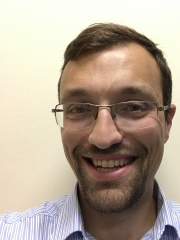
Written by Selena Langner
Contact: Jess Hunt- Ralston
Ethical Leaders Promote Creative Teams Under the Right Conditions
Dec 11, 2023 —

In a world where CEOs become thought leaders, being an ethical leader is paramount. But does this type of leader inspire their team to be creative? For years, it’s been a common assumption in the organizational behavior field that the more ethical a leader is, the less innovative their employees are. But new research from the Georgia Institute of Technology shows that ethical leaders are more likely to increase team creativity.
“It bothered me that there are a number of studies that talk about how you can be ethical, or you can be creative,” said Scheller College of Business Professor Christina Shalley. “I didn't think you had to choose, so I wanted to understand under what conditions can you be both ethical and creative.”
In a study of fast-food workers in South Korea, the researchers surveyed both managers and their employees about their creativity and their leadership’s ethics. They found that employees are most creative if their ethical leaders create a cohesive team identity and resolve problems quickly.
Shalley and her team published their findings in the paper, "How Does Ethical Leadership Relate to Team Creativity? The Role of Collective Team Identification and Need for Cognitive Closure,” in Group & Organization Management.
Defining Creativity and Ethics
Shalley has been studying creativity for more than 30 years in the organizational behavior field. Here, creativity is understood as ideas that are novel and useful. Employees who solve problems are often considered the most creative. This break-the-rules mindset seems to be the opposite of ethical leadership at first.
Ethical leaders follow societal norms and appropriate behavior. They demonstrate these ethics in their personal actions and interpersonal relationships, and influence their employees to follow suit via communication, reinforcement, and decision-making. Traditionally, the need for societal conformity appears to undermine the rule-breaking spirit of creativity.
The researchers suspected that there were conditions among ethical leaders that could mitigate this creativity/ethics schism. The first is collective team identification — how emotionally attached employees are to their team. A strong collective team identity can create common ground among team members with differing opinions and lead to clearer communication. A safer workspace can encourage employees to share their creative ideas.
The second condition is the collective need for cognitive closure or finding an answer in an ambiguous situation. Although this can lead to individuals making quick decisions instead of seeking creative alternatives, an ethical leader can use it for the team’s benefit. Quick decisions can make the team feel more cohesive and effectively increase collective team identification.
“An ethical leader can definitely motivate their employees to be creative, but it’s a more complex issue,” Shalley said.
Studying Creativity and Ethics
To confirm these hypotheses, the researchers conducted a study with employees and leaders at a South Korean fast-food chain that supplies poultry to food vendors and operates restaurants of their own. Creativity is a fundamental value of the company, making them ideal for this research.
They surveyed 92 leaders and 55 teams with anywhere from three to 30 members, or 327 total team members, with three surveys separated by three weeks each. Employees received the first two surveys and managers received the last survey that asked about the level of team creativity, such as how often they came up with novel and useful solutions to problems at work. The employees’ questions focused on three areas:
- Ethical leadership: measured by whether the leader discussed ethics with their employees or set an example of how to do things ethically.
- Collective need for cognitive closure: 15 questions on a scale of agreement of how well employees handled uncertainty.
- Collective team identification: employees used a scale to rate how close they felt to the team.
The results confirmed that ethical leaders do contribute to more creative teams and suggest that leaders wishing to promote more innovation should set clear standards and rules for their teams.
“We are interested in how you can structure the work environment to enable employees to be more creative,” Shalley said. “Ethical leadership fosters team creativity by strengthening collective team identification.”
CITATION: Keem, S., Koseoglu, G., Jeong, I., & Shalley, C. E. (2023). How Does Ethical Leadership Relate to Team Creativity? The Role of Collective Team Identification and Need for Cognitive Closure. Group & Organization Management, 0(0).
DOI: https://doi.org/10.1177/10596011211072951
Tess Malone, Senior Research Writer/Editor
tess.malone@gatech.edu
Three Faculty Members Appointed Carter N. Paden, Jr. Distinguished Chair
Dec 07, 2023 — Atlanta, GA

Pictured left to right: Matthew McDowell, Min Zhou, and Ting Zhu.
Three faculty members in the George W. Woodruff School of Mechanical Engineering have been appointed Carter N. Paden, Jr. Distinguished Chair for innovation in Material Science and Metals Processing, effective January 1, 2024.
Associate Professor Matthew McDowell, Professor Min Zhou, and Woodruff Professor Ting Zhu will hold the position for a five-year term and receive discretionary funding to support their educational and research activities.
These appointments recognize each of the three recipients for their intellectual leadership and broader impact in the field of material processing, and the ability to help the Woodruff School grow in emerging areas of importance.
“Throughout their careers, Matt, Min, and Ting have been leaders in their fields and made significant contributions to research,” said Devesh Ranjan, Eugene C. Gwaltney, Jr. School Chair. “They are highly deserving of this endowed chair position, and I know David McDowell, who held the Paden Chair until his retirement earlier this year, is proud to pass it on to his son and former long-term collaborators and mentees.”
McDowell’s research focuses on developing materials for next-generation battery systems, as well as understanding dynamic materials transformations in electrochemical energy devices. He leads the newly established Georgia Tech Advanced Battery Center (GTABC) with co-director Gleb Yushin, a professor in the School of Materials Science and Engineering. The new center will build community at the Institute, work to enhance research and educational relationships with industry partners, and create a new battery manufacturing facility on Georgia Tech’s campus.
Zhou's research interests concern material behavior over a wide range of length scales. His research emphasizes finite element and molecular dynamics simulations as well as experimental characterization with digital diagnostics.
Zhu's research focuses on the mechanical behavior of advanced engineering materials at the nano to macro-scale. He conducts modeling and simulations using the atomistic, continuum, and multiscale methods.
The endowed chair was made possible by Georgia Tech alumnus Carter N. Paden, Jr., IM 1951, who had a lifelong career in metals processing.
Ashley Ritchie (ashley.ritchie@me.gatech.edu)
New IEN Center to Research Wearable Technologies
Dec 05, 2023 —
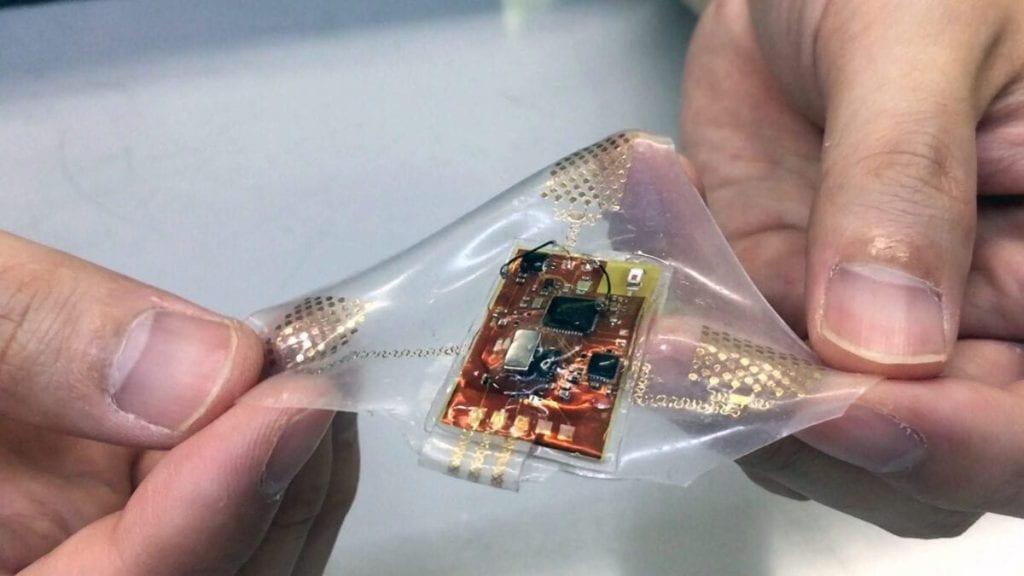
A new research center in the Institute for Electronics and Nanotechnology (IEN) will help bring together human-centered bioelectronics technology research to improve human healthcare and expand human-machine interface technologies.
The Wearable Intelligent Systems and Healthcare (WISH) Center will work to push innovation in wearable sensors and electronics technologies. Focus areas of the center will include electronics, artificial intelligence, biological science, material sciences, manufacturing, system design, and medical engineering.
“We are excited by the promise of bioelectronics improving human health and all the exciting science engineering that is required to make it a reality,” said Michael Filler, interim executive director of IEN.
WISH is directed by W. Hong Yeo, associate professor in Georgia Tech’s George W. Woodruff School of Mechanical Engineering and the Wallace H. Coulter Department of Biomedical Engineering at Georgia Tech and Emory, and Yuhang Hu, associate professor in the School of Chemical and Biomolecular Engineering at Georgia Tech.
“I founded WISH to bring together Georgia Tech’s expertise in various disciplines and to create opportunities for developing wearable bioelectronics and human-machine technologies leading to better lives and communities,” said Yeo.
Yeo’s research focuses on developing soft sensors, electronics and robotics for health monitoring and disease diagnosis at the intersection of human and machine interaction. Other researchers in the center represent disciplines from across Georgia Tech’s Colleges of Engineering, Computing, Sciences, Design, and Liberal Arts; Emory University; and Children’s Healthcare of Atlanta.
WISH will be one of IEN’s 10 strategic research centers, along with the 3D Systems Packaging Research Center, a graduated NSF Engineering Research Center focusing on advanced packaging using 2.5D and 3D heterogeneous integration technologies, and the Georgia Electronic Design Center, one of the world’s largest university-based semiconductor research centers. WISH is an evolution of the Center for Human-Centric Interfaces and Engineering, which received seed funding from IEN to focus on collaborative research for human-centered design, biofeedback control, and integrated nanosystems to advance human-machine interaction in the scope of healthcare.
IEN supports early-stage research in underfunded research areas that span all disciplines in science and engineering through its seed grant programs, which focus on research in biomedicine, electronics, optoelectronics and photonics, and energy applications.
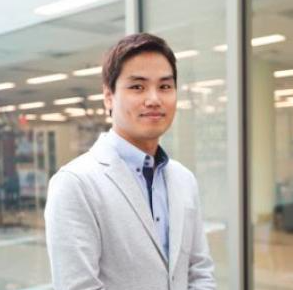
Amelia Neumeister, Research Communications
